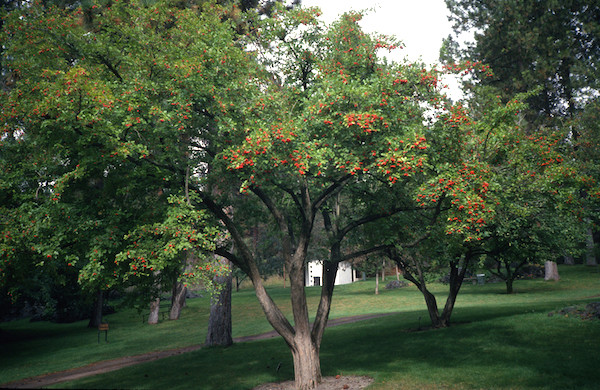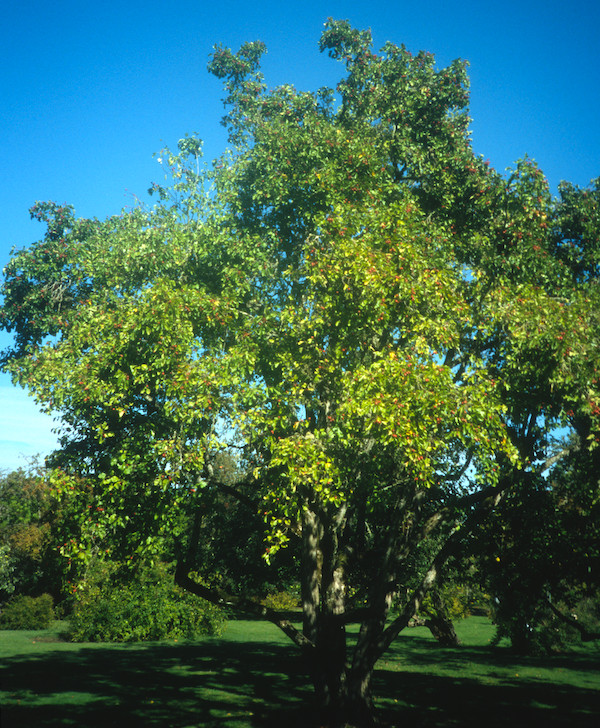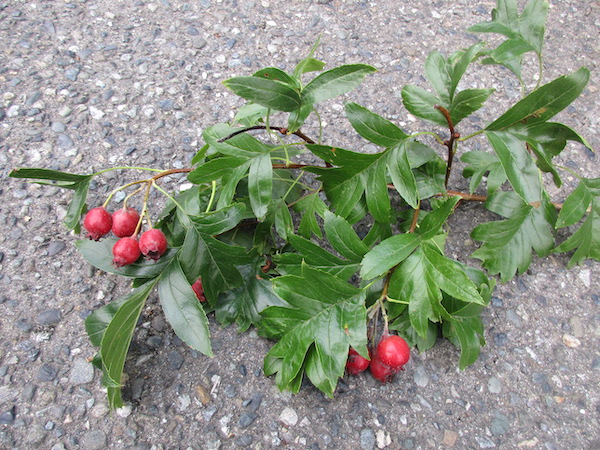Plant of the Month: September 2024
|
| Chinese Hawthorn |
Cratægus pinnatifida Bge.
|
(ROSACEÆ); Rose Family
|
| Chinese Hawthorn is undeservedly rare in Seattle cultivation; only one specimen is known to me. It is crowded in a back yard. This species is a native of Russian Far East to China & Korea, and is grown there commercially for its edible fruit. The only large old tree I have seen in Washington is at Spokane's Finch Arboretum. In 1993, it measured 22 feet tall, 32 feet wide, its trunk circumference 3 feet 9 inches. Another large old specimen is in Salem, Oregon, at Bush's Pasture Park. These days, some nurseries sell the clone Red Sun --that possibly some people in Seattle have bought and planted. |
| The tree resembles the very common Cratægus monogyna, but has bigger leaves of brighter green; shreddy bark; is less thorny (thorns to three-forths of an inch long); its haws (fruits) are much more showy. Leaves lobed conspicuously (hence the name pinnatifida), 2 to 4 inches long, or more on strong shoots. Flowers are white, small, in clusters, more or less half an inch wide, and are bee-pollinated. The haws (fruits) are shiny bright red, half an inch to three-quarters of an inch long, 2 to 5 seeded. The fruit has turned red by September. The fall leaf color is yellowish-orange in October. |
| The trees can handle freezing cold, or summer heat, and are not especially thirsty. Earth has some 223 different species of Cratægus, but few make fruit that is favored as human food. This Chinese large shrub or small tree, notably in its var. major of north China, is the most significant economically. In China, it is called 山楂 Shan Zha (Shan Cha). Names appled in English are Chinese Hawthorn, Chinese Bigleaf Hawthorn, Asian Hawthorn, and Peking Hawthorn. |
| Its var. major has extra large leaves and fruit. It is thornless or nearly so, more treelike than the wild form, but still small, and slow-growing. Its crown is heavy and leafy. Leaves are less deeply lobed, shiny, larger, up to 6 inches long, often cupped or folded, with unusually long stems (to 2 and three-eighths); and can turn rich red or purplish in the fall. The bright red haws speckled with light dots, can measure 1 and a quarter inch wide, sometimes pear-shaped, with a substantial pit at the base. The haws are both ornamental and edible. But their big size makes them messy when they drop. We should eat them. They can be enjoyed fresh; dehydrated; made into candy, jam, and the like. |
A relative, also Chinese, also with big fruit, is Cratægus hupehensis Sarg. Only one specimen was known to me in Seattle, and is now gone.
Back |

Chinese Hawthorn at Spokane's Finch Arboretum ; photo by ALJ in 1993
|

Chinese Hawthorn at Spokane's Finch Arboretum ; photo by ALJ in 1993
|

Chinese Hawthorn at Salem's Bush's Pasture Park ; photo by ALJ in 2004
|

Chinese Hawthorn foliage & fruit ; photo by ALJ in Seattle this September
|

Chinese Hawthorn dehydrated fruit ; photo by ALJ
|
|
|

